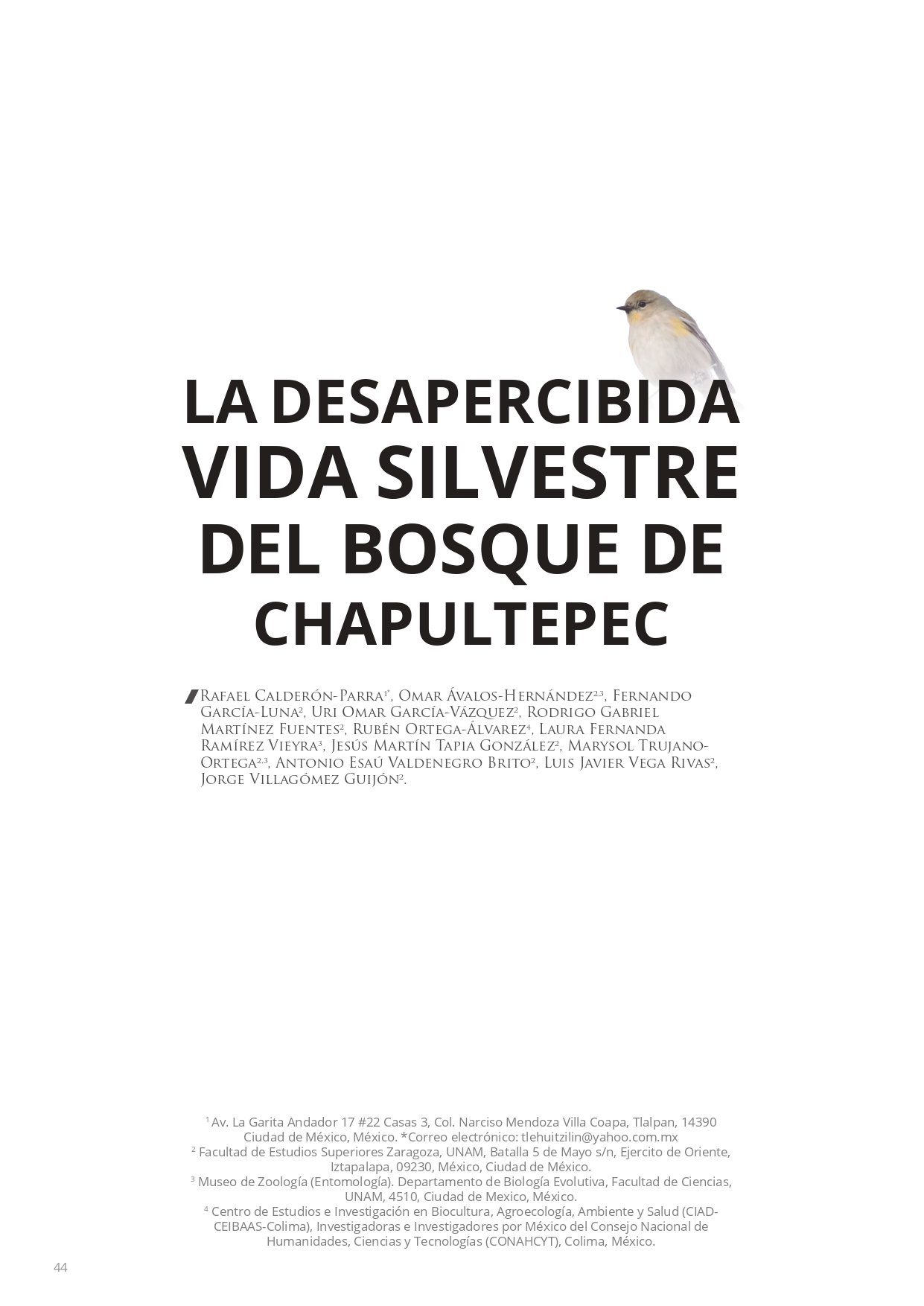La desapercibida vida silvestre del Bosque de Chapultepec
DOI:
https://doi.org/10.29105/bys7.14-129Keywords:
urban green areas, urban forest, biodiversity, conservation, ecological restoration, urban ecologyAbstract
Chapultepec Forest has passed through multiple socio-environmental transformations during its history. It has been considered as a sacred place, it was the residence of rulers, a source of potable water, a hunting ground, and a fortress; currently, it is a place for culture and recreation. The loss and changes of the original vegetation, constructions, the introduction of species, and the intensification of human presence are the challenges that wildlife has faced. Nowadays, multiple actors are looking to implement environmental restoration actions in order to favor the establishment of native flora and fauna. To do this, it is necessary to know its current status through scientific research. The study we conducted was focused on birds, butterflies, amphibians, reptiles, flies, and bees. Surveys covered the tree sections of the forest and the one called “fourth section”, and we included a part of the surrounding urban area as a comparison site. We found 64 species of bees and flies, 93 of butterflies, 122 of birds, 16 of reptiles, and three species of amphibians. The results confirm that the Chapultepec Forest is an urban refuge for wildlife, especially the third and fourth sections, where the most favorable environmental conditions for native fauna are found. The creation of pollination gardens, the increase in the variety of trees and shrubs, as well as the regulation of human access and the appropriate maintenance of water bodies could favor local wildlife. Citizen science could be promoted for the development of environmental education activities and facilitate the collection of information that might help to improve the environmental conditions of the park. The future of Chapultepec is in everyone's hands and the benefits of its proper management will be for society and wildlife.
Downloads
References
Ávalos-Hernández, O., M. Trujano-Ortega, R. Ortega-Álvarez, R.G. Martínez-Fuentes, R. Calderón-Parra, F. García-Luna, L. Ramírez-Vieyra, J. Tapia-González, J. Vega-Rivas, J. Villagómez-Guijón, A. Valdenegro-Brito, U.O. García-Vázquez. 2024. How does urbanization affect the fauna of the largest urban forest in Mexico? Urban Forestry & Urban Greening. 92 (2024) 128191. https://doi.org/10.1016/j.ufug.2023.128191 DOI: https://doi.org/10.1016/j.ufug.2023.128191
Comisión Nacional para el Conocimiento y Uso de la Biodiversidad (CONABIO), Secretaría del Medio Ambiente del Distrito Federal (SEDEMA). 2016. La biodiversidad en la Ciudad de México. CONABIO/SEDEMA. México. http://200.12.166.51/janium/Documentos/13054.pdf
del Coro, M., E. del Val. 2021. Jardines de polinizadores como estrategia de conservación en las ciudades. Pp. 14-26. En: Mercado, N y E. del Val (Eds.). Manejo y conservación de fauna en ambientes antropizados. Refama/UAQ. México, 191 pp.
Díaz-Batres, M. E., J. Llorente-Busquets. 2011. Mariposas de Chapultepec. Guía Visual. Ed. Panorama, México, 156 pp.
Gómez T., A. 2002. Los jardines de Chapultepec en el siglo XIX. Arqueología Mexicana. México, X (57): 48-53.
Ortega-Álvarez, R., R. Calderón-Parra, F. García-Luna. 2022. Trees and people determine the feeding activity of a migratory bird in an urban mega-park of Mexico City. Avian Biology Research 15(3):149-157. https://doi.org/10.1177/17581559221113641 DOI: https://doi.org/10.1177/17581559221113641
Ruíz N., V. M. 2002. Los jardines de Chapultepec y sus reflejos novohispanos. Arqueología Mexicana. X (57): 42-47.
Solís O., F. 2002. Chapultepec, espacio ritual y secular de los tlatoani aztecas. Arqueología Mexicana. X (57): 36-40.
Tovar de Teresa, L., S. Alcántara O. 2002. Los jardines en el siglo XX: el viejo Bosque de Chapultepec. Arqueología Mexicana. X (57): 56-65.







